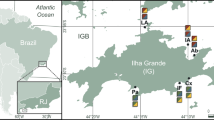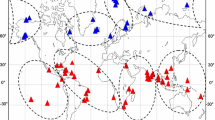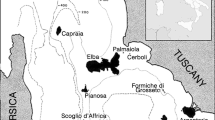Abstract
‘Hotspots’ of biodiversity (taxonomic richness, endemism, taxonomic affinities between communities) at small (α), medium (β) and larger (γ) scales of diversity were examined for marine sponge populations throughout tropical and subtropical Australia, with the faunas of Vanuatu, Palau and Thailand used as outgroups for comparison. Spatial and numerical (ordination) models and hierarchic classifications delineated 37 β and 13 γ scale faunas from 1343 investigated localities using a pool of 2324 species. The Australian taxonomic literature was ignored completely to avoid the many still unresolved taxonomic problems and to allow equal treatment of collecting localities. Richness and endemism varied considerably between marine areas, for species and genera at all spatial scales, with gradients strongly corroborated by hierarchic taxonomic relationships between faunas. Richness and endemism were equally effective indicators of biodiversity ‘hotspots’, whereas species-level vs. genus-level data produced differing patterns, with the latter substantially underestimating biodiversity and marine area relationships, and consequently a poor 'surrogate’ for species data. Patterns of taxa shared between adjacent areas were more informative than richness and endemism data alone, as they more accurately reflect the processes in these areas. Latitudinal gradients in sponge diversity were not evident, whereas various environmental factors were prominent at α scales and biogeographic factors were prominent at β and γ scales of diversity. An example of a small (α) scale diversity fauna revealed substantial spatial heterogeneity (mean of 41 spp/locality, 33% apparently endemic, and a total fauna of 226 spp) containing few ubiquitous species (40% or 78 spp), with adjacent reefs having relatively low faunal similarity (mean 33%). Faunas at the medium (β) scale of diversity were less heterogeneous (mean 127 spp/region, 27% apparently endemic to a particular region, with a total fauna of 2324 spp), containing a significantly larger dataset (829 spp) found in >1 region to assess taxonomic affinities. At the larger (γ) scale of diversity faunas were far more heterogeneous (mean 263 spp/region, 47% apparently endemic to a particular region) containing a smaller dataset (only 588 spp or 26% of the fauna with >1 species/region) to assess taxonomic affinities. Consequently, sponge faunas at the α and γ scales of diversity are ineffective and inappropriate as biodiversity models, respectively, with γ scale diversity also less relevant as a practical tool for marine resource management and marine area conservation.
Similar content being viewed by others
References
Anonymous 1997. Marine Industry Development Strategy. Department of Industry, Science and Tourism, Canberra.
Barber P.H., Palumbi S.R., Erdmann M.V. and Moosa M.K. 2000. A marineWallace's line? Nature 406: 692-693.
Balmford A. and Long A. 1996. Across-country analyses of biodiversity congruence with current conservation efforts in the tropics. Conservation Biology 9: 1539-1547.
Blanchard D. and Bourget E. 1999. Scales of coastal heterogeneity: influence of intertidal community structure. Marine Ecology Progress Series 179: 163-173.
Bridgewater P.B. 2000. The Global Taxonomic Initiative-a perspective from the user community. The New Panorama of Animal Evolution. XVIIIth International Congress of Zoology. 28 August-2 September 2000. Hellenic Zoological Society, Athens, p. 153.
Bunt J.S. 1987. The Australian marine environment. In: Dyne G.R. and Walton D.W. (eds), Fauna of Australia.Vol 1A. General Articles. Australian Government Publishing Service, Canberra, pp. 17-42.
Butler A.J. and Connolly R.M. 1999. Assemblages of sessile marine invertebrates: still changing after all these years? Marine Ecology Progress Series 182: 109-118.
Butler T. 2000. Life on earth. Museums Journal July: 18-21.
Clifford H.T. and Stephenson W. 1975. An Introduction to Numerical Classification. Academic Press, New York.
Crame J.A. and Clarke A. 1997. The historical component of marine taxonomic diversity gradients. In: Ormond R.F.G., Gage J.D. and Angel M.V. (eds), Marine Biodiversity: Patterns and Processes. Cambridge University Press, Cambridge, pp. 258-273.
Davie P.J.F. and Hooper J.N.A. 1998. Patterns of biodiversity in the marine invertebrate and fish communities of Moreton Bay. In: Tibbets I.R., Hall N.J. and DennisonW.D. (eds), Moreton Bay and Catchment. University of Queensland, Brisbane, pp. 331-346.
Davies P. 1994. Evolution of the Great Barrier Reef. Australian Geologist 92: 21-24.
De Voogd N.J., van Soest R.W.M. and Hoeksema B.W. 1999. Cross-shelf distribution of southwest Sulawesi reef sponges. Memoirs of the Queensland Museum 44: 147-154.
Fauchald K. 2000. The taxonomic impediment in the study of marine invertebrates. The New Panorama of Animal Evolution. XVIIIth International Congress of Zoology, 28 August-2 September 2000. Hellenic Zoological Society, Athens, p. 152.
Grassle J.F. 1991. Deep-sea benthic biodiversity. The ocean bottom supports communities that may be as diverse as those of any habitat on Earth. Biodiversity 41: 464-469.
Gray J.S. 1997. Gradients in marine biodiversity. In: Ormond R.F.G., Gage J.D. and Angel M.V. (eds), Marine Biodiversity: Patterns and Processes. Cambridge University Press, Cambridge, pp. 18-34.
Guichard F. and Bourget E. 1998. Topographic heterogeneity, hydrodynamics and benthic community structure: a scale dependent cascade. Marine Ecology Progress Series 135: 89-100.
Hillis D.M. and Bull J.J. 1993. An empirical test of bootstrapping as a method for assessing confidence in phylogenetic analysis. Systematic Biology 42: 182-192.
Hoeksema B.W. 2000. The East Indies triangle of marine biodiversity. In: Hopley D., Hopley P.M., Tamelander J. and Done T. (eds), Ninth International Coral Reef Symposium. World Coral Reefs in the New Millennium: bridging research and management for sustainable development. State Ministry for the Environment, Indonesia, Indonesian Institute of Sciences & The International Society for Reef Studies, Bali, Indonesia, p.45.
Hooper J.N.A. 1991. Revision of the family Raspailiidae (Porifera: Demospongiae), with description of Australian species. Invertebrate Taxonomy 5: 1179-1415.
Hooper J.N.A. 1994. Coral reef sponges of the Sahul Shelf-a case for habitat preservation. Memoirs of the Queensland Museum 36: 93-106.
Hooper J.N.A. 1996. Revision of Microcionidae (Porifera: Poecilosclerida: Demospongiae), with description of Australian species. Memoirs of the Queensland Museum 40: 1-626.
Hooper J.N.A. and Levi C. 1994. Biogeography of Indo-west Pacific sponges: Microcionidae, Raspailiidae, Axinellidae. In: van Soest R.W.M., van Kempen T.M.G. and Braekman J.-C. (eds), Sponges in Time and Space. Balkema, Rotterdam, pp. 191-212.
Hooper J.N.A. and Wiedenmayer F. 1994. Porifera. In: Wells A. (ed.), Zoological Catalogue of Australia Vol. 12. CSIRO, Melbourne, pp. 1-621.
Hooper J.N.A., Kennedy J.A., List-Armitage S.E., Cook S.D. and Quinn R. 1999. Biodiversity, species composition and distribution of marine sponges in northeast Australia. Memoirs of the Queensland Museum 44: 263-274.
Hooper J.N.A., Kennedy J.A. and van Soest R.W.M. 2000. Annotated checklist of sponges (Porifera) of the South China Sea region. The Raffles Bulletin of Zoology Supplement (8): pp. 125-207.
Huston M. 1985. Patterns of species diversity on coral reefs. Annual Reviews of Ecology and Systematics 16: 149-177.
IMCRA Technical Group (1998) Interim Marine and Coastal Regionalisation for Australia. An ecosystem-based classification for marine and coastal environments.Version 3.3. Environment Australia, Commonwealth Department of the Environment, Canberra.
Jensen R., Borowitzka L., Bray N., Davies P., Fandry C., Jeffriess B., Johnson C., Hudlow T., Lennard D., Marsh H., Pigram C. and Reichelt R. (1999) Australia's Marine Science and Technology Plan. The Marine Science and Technology Plan Working Group. Ausinfo, Commonwealth of Australia, Canberra.
Kerr J.T. 1997. Species richness, endemism, and choice of areas for conservation. Conservation Biology 11: 1094-1100.
Klautau M., Sole-Cava A.M. and Borojevic R. 1994. Biochemical systematics of sibling sympatric species of Clathrina (Porifera: Calcarea). Biochemical Systematics and Ecology 22: 367-375.
Klautau M., Russo C.A.M., Lazoski C., Boury-Esnault N., Thorpe J.P. and Sole-Cava A.M. 1999. Does cosmopolitanism result from overconservative systematics? A case study using the marine sponge Chondrilla nucula. Evolution 53: 1414-1422.
Kohn A.J. 1997. Why are coral reef communities so diverse? In: Ormond R.F.G., Gage J.D. and Angel M.V. (eds), Marine Biodiversity: Patterns and Processes. Cambridge University Press, Cambridge, pp. 201-215.
Lehnert H. and Fischer H. 1999. Distribution patterns of sponges and corals down to 107 m off North Jamaica. Memoirs of the Queensland Museum 44: 307-331.
Mace G.M., Balmford A., Boitani L., Cowlishaw G., Dobson A.P., Faith D.P. et al. 2000. It's time to work together and stop duplicating conservation efforts. Nature 405: 393.
Maddock A. and Du Plessis M.A. 1999. Can species data only be appropriately used to conserve biodiversity? Biodiversity and Conservation 8: 603-615.
Medlin L. 1998. When the boat comes in. Nature 395: pp658.
Meyer C. and Paulay G. 2000. Indo-west Pacific diversity: phylogenetic evidence from cowries for a mozaic of causes. In: Hopley D., Hopley P.M., Tamelander J. and Done T. (eds), Ninth International Coral Reef Symposium.World Coral Reefs in the New Millennium: bridging research and management for sustainable development. State Ministry for the Environment, Indonesia, Indonesian Institute of Sciences & The International Society for Reef Studies, Bali, Indonesia, p. 45.
Myers N., Mittermeier R.A., Mittermeier C.G., da Fonseca G.A.B. and Kents J. 2000. Biodiversity hotspots for conservation priorities. Nature 403: 853-858.
National Geographic Society 2000. The Coral World Map. Committee for Research and Exploration, Washington, DC.
Ormond R.F.G., Gage J.D. and Angel M.V. 1997. Marine Biodiversity: Patterns and Processes. Cambridge University Press, Cambridge, pp. 201-215.
Pearce A.F. and Walker D.I. 1991. The Leeuwin Current: an influence on the coastal climate and marine life of Western Australia. Journal of the Royal Society of Western Australia 74: 1-140.
Poore G.C.B. 1995. Biogeography and diversity of Australia's marine biota. In: Zann L.P. and Kailola P. (eds), State of the Marine Environment Report for Australia. Technical Annex 1: The Marine Environment. Great Barrier Reef Marine Park Authority, Department of Environment, Sport and Territories, Canberra, pp. 75-84.
Poore G.C.B. and Wilson G.D.F. 1993. Marine species richness. Nature 361: 597-598.
Possingham H. 1999. The Global Taxonomic Initiative (GTI) and the taxonomic impediment: what are they and why should I care? Southern Connection 16: 6-8.
Richer De Forges B., Koslow J.A. and Poore G.C.B. 2000. Diversity and endemism of the benthic seamount fauna in the southwest Pacific. Nature 405: 944-947.
Roberts C.M., Hawkins J.P., McAllister D.E., McClean C.J. and Werner T. 2000. Global priority regions for coral reef conservation. In: Hopley D., Hopley P.M., Tamelander J. and Done T. (eds), Ninth International Coral Reef Symposium. World Coral Reefs in the New Millennium: bridging research and management for sustainable development. State Ministry for the Environment, Indonesia, Indonesian Institute of Sciences & The International Society for Reef Studies, Bali, Indonesia, p. 223.
van Soest R.W.M. 1993. Distribution of sponges on the Mauritanian continental shelf. In: Wolff W.J., van der Land J., Nienhuis P.H. and de Wilde P.A.W.J. (eds), Ecological studies in the coastal waters of Mauritania. Hydrobiologia 258: 95-106.
van Soest R.W.M. 1994. Demosponge distribution patterns. In: van Soest R.W.M., van Kempen T.M.G. and Braekman J.-C. (eds), Sponges in time and space. Balkema, Rotterdam, pp. 213-224.
van Soest R.W.M. and Hajdu E. 1997. Marine area relationships from twenty sponge phylogenies: A comparison of methods and coding strategies. Cladistics 13: 1-20.
Sole-Cava A.M., Boury-Esnault N., Vacelet J. and Thorpe J.P. 1992. Biochemical genetic divergence and systematics in sponges of the genera Corticium and Oscarella (Demospongiae: Homoscleromorpha) in the Mediterranean Sea. Marine Biology 113: 299-304.
SPSS (1999) Systat 9.0. SPSS Inc., Chicago, Illinois.
Swofford D.L. 2000. Paup. Phylogenetic Analysis Using Parsimony.Version 4.0b4a. Sinauer Associates, Sunderland, Massachusetts.
Taylor J.D. 1997. Diversity and structure of tropical Indo-Pacific benthic communities: Relation to regimes of nutrient input. In: Ormond R.F.G., Gage J.D. and Angel M.V. (eds), Marine Biodiversity: Patterns and Processes. Cambridge University Press, Cambridge, pp. 178-199.
United States Hydrographic Office 1947. Atlas of Surface Currents. United States Hydrographic Office, Washington, DC.
Vane-Wright R.I., Humphries C.J. and Williams P.H. 1991.What to protect?-Systematics and the agony of choice. Biological Conservation 55: 235-254.
Vanney J.-R. 1991. Introduction a la Geographie de l'Ocean. Une vue nouvelle du monde. Oceanis 17(1-2): 1-214.
Veron J.E.N. 1993. A biogeographic database of hermatypic corals. Species of the central Indo-pacific. Genera of the World. Australian Institute of Science Monograph Series Vol 1: pp. 1-433.
Veron J.E.N. 1995. Corals in Space and Time. The Biogeography and Evolution of the Scleractinia. University of New South Wales Press, Sydney.
Walker R.H. and Farquhar G. 1998. An evaluation of the Australian Biological Resources Study and the Biodiversity Program. Consultative report produced for Environment Australia. Environment Australia, Canberra, January 1998.
Williams P.H., Gaston K.J. and Humphries C.J. 1994. Do conservationists and molecular biologists value differences between organisms in the same way? Biodiversity Letters 2: 67-78.
Williams P.H., Gaston K.J. and Humphries C.J. 1997. Mapping biodiversity value worldwide: combining higher-taxon richness from different groups. Proceedings of the Royal Society, Biological Sciences 264: 141-148.
Wilkinson C.R. and Cheshire A.C. 1989. Patterns in the distribution of sponge populations across the central Great Barrier Reef. Coral Reefs 8: 127-134.
Wilson E.O. 1992. The Diversity of Life. Belknap, Cambridge, Massachusetts.
Wilson E.O. 2000. Biodiversity.Vanishing before our eyes. Time Special Edition 16A, April-May, Time Australia Magazine, Sydney, pp. 29-34.
Woerheide G. 1998. The reef cave dwelling ultraconservative coralline demosponge Astrosclera willeyana Lister 1900 from the Indo-Pacific. Facies 38: 1-88.
Woerheide G., Degnan D.M. and Hooper J.N.A. 2000. Population phylogenetics of the common Coral reef sponges Leucetta spp. and Pericharax spp. (Porifera: Calcarea) from the Great Barrier Reef and Vanuatu. In: Hopley D., Hopley P.M., Tamelander J. and Done T. (eds), Ninth International Coral Reef Symposium. World Coral Reefs in the New Millennium: bridging research and management for sustainable development. State Ministry for the Environment, Indonesia, Indonesian Institute of Sciences & The International Society for Reef Studies, Bali, Indonesia, p. 23.
Zar J.H. 1999. Biostatistical Analysis. Prentice Hall, Englewood Cliffs, New Jersey.
Author information
Authors and Affiliations
Rights and permissions
About this article
Cite this article
Hooper, J.N., Kennedy, J.A. & Quinn, R.J. Biodiversity ‘hotspots’, patterns of richness and endemism, and taxonomic affinities of tropical Australian sponges (Porifera). Biodiversity and Conservation 11, 851–885 (2002). https://doi.org/10.1023/A:1015370312077
Issue Date:
DOI: https://doi.org/10.1023/A:1015370312077




